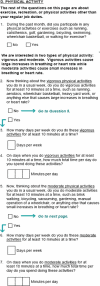Predictors of inactive lifestyle among adult survivors of childhood cancer: a report from the Childhood Cancer Survivor Study
- PMID: 19224548
- PMCID: PMC2692052
- DOI: 10.1002/cncr.24209
Predictors of inactive lifestyle among adult survivors of childhood cancer: a report from the Childhood Cancer Survivor Study
Abstract
Background: : Participation in physical activity is important for childhood cancer survivors, because inactivity may compound cancer/treatment-related late effects. However, some survivors may have difficulty participating in physical activity, and these individuals need to be identified so that risk-based guidelines for physical activity, tailored to specific needs, can be developed and implemented. The objectives of the current study were to document physical activity patterns in the Childhood Cancer Survivor Study (CCSS) cohort, to compare the physical activity patterns with siblings in the CCSS and with a population-based sample from the Behavioral Risk Factor Surveillance System, and to evaluate associations between diagnosis, treatment, and personal factors in terms of the risk for an inactive lifestyle.
Methods: : Percentages of participation in recommended physical activity were compared among survivors, siblings, and population norms. Generalized linear models were used to evaluate the associations between cancer diagnosis and therapy, sociodemographics, and the risk for an inactive lifestyle.
Results: : Participants included 9301 adult survivors of childhood cancer and 2886 siblings. Survivors were less likely than siblings (46% vs 52%) to meet physical activity guidelines and were more likely than siblings to report an inactive lifestyle (23% vs 14%). Medulloblastoma (35%) and osteosarcoma (27%) survivors reported the highest levels of inactive lifestyle. Treatments with cranial radiation or amputation were associated with an inactive lifestyle as were being a woman, black race, older age, lower educational attainment, underweight or obese status, smoking, and depression.
Conclusions: : Childhood cancer survivors were less active than a sibling comparison group or an age- and sex-matched population sample. Survivors who are at risk for an inactive lifestyle should be considered high priority for developing and testing of intervention approaches. Cancer 2009. (c) 2009 American Cancer Society.
Figures


References
-
- National Cancer Institute Late effects of treatment for childhood cancer (PDQ) Health Professional Version. www.cancer.gov/cancertopics/pdq/treatment/lateeffects. Accessed March 20, 2008. - PubMed
-
- Landier W, Bhatia S, Eshelman DA, et al. Development of risk-based guidelines for pediatric cancer survivors: the Children's Oncology Group Long-Term Follow-Up Guidelines from the Children's Oncology Group Late Effects Committee and Nursing Discipline. J Clin Oncol. 2004;22:4979–4990. - PubMed
-
- Lee IM, Hsieh CC, Paffenbarger RS., Jr. Exercise intensity and longevity in men. The Harvard Alumni Health Study. Jama. 1995;273:1179–1184. - PubMed
-
- Leon AS, Connett J, Jacobs DR, Jr., Rauramaa R. Leisure-time physical activity levels and risk of coronary heart disease and death. The Multiple Risk Factor Intervention Trial. JAMA. 1987;258:2388–2395. - PubMed
-
- Lindsted KD, Tonstad S, Kuzma JW. Self-report of physical activity and patterns of mortality in Seventh-Day Adventist men. J Clin Epidemiol. 1991;44:355–364. - PubMed

